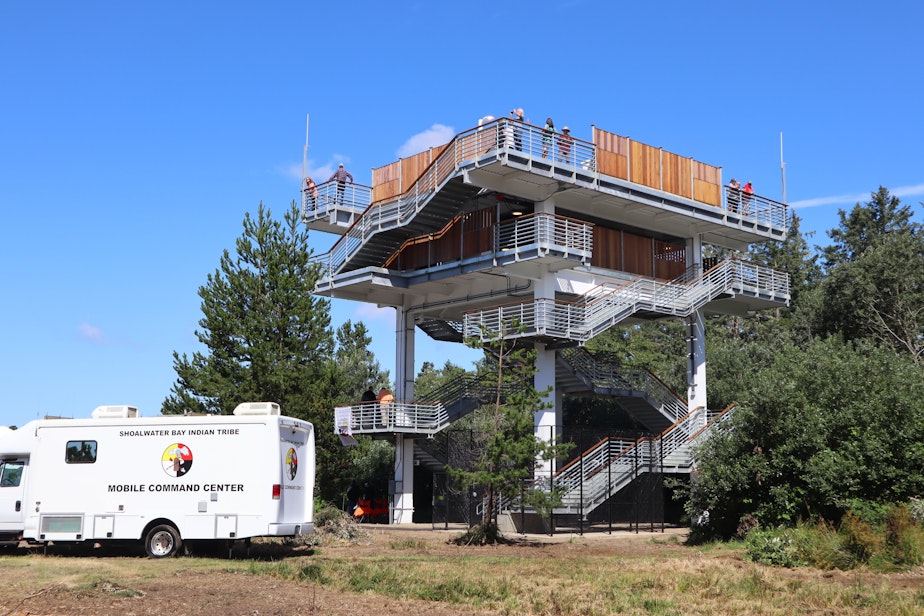Coastal Washington tribe creates higher ground by building tsunami tower, first of its type here

There is a new option to escape a tsunami if you’re on the southwest coast of Washington when the Big One strikes. The Shoalwater Bay Indian Tribe on Friday dedicated a 50-foot tall evacuation tower in Tokeland, Washington. Tribal leaders and the Federal Emergency Management Agency said the new tsunami refuge platform should be an example and inspiration for other vulnerable coastal communities.
When the next magnitude 9.0 rip of the offshore Cascadia fault zone occurs, people on the Pacific Northwest coast will have about 15 to 35 minutes to get to high ground to escape a possible tsunami. Tokeland is on a long, flat peninsula with no high ground within walking or running distance for many of the people there.
“This tower will save our lives someday,” said Shoalwater tribal council member Lynn Clark at the joyful dedication ceremony, which was followed by a salmon bake to thank the project’s many partners.
The tribe’s emergency management director, Ken Ufkin, said he can sleep better now that manmade high ground exists in the form of the sturdy, double decker tsunami refuge tower. The tower stands close to the midpoint of the nearly three-mile long Tokeland Peninsula.
"This allows folks even if it's 2:30 in the morning in your pajamas to scoop up your family and make it here in a very short amount of time – in under a 15 minute window for nearly everyone from Tokeland Point to the heart of the reservation," Ufkin said.
Sponsored
The tower will be open to all in a disaster. The tower platforms have a capacity of more than 400 people, which is considerably more than the tribal population of the small Shoalwater Bay reservation. So, a lot of the tribe's neighbors can escape the waves there, too.
The Tokeland evacuation tower resembles free-standing tsunami towers previously built in Japan, but it is the first of its type in North America. The two other purpose-built tsunami refuges on the Northwest coast -- in Newport, Oregon, and Westport, Washington -- are reinforced platforms on the roofs of a school or university building.
Design engineer Cale Ash, who worked on the Tokeland tower for Degenkolb Engineers, said tsunami experts modeled the maximum wave height at the location near the mouth of Willapa Bay as 16.3 feet. Ash said the design team rounded up to 20.2 feet to be safe. He said the floor of the lower platform is 33 feet above the ground and the floor of the upper platform is 43 feet high.
Ash told the audience at the dedication that the tower rests on concrete pilings that go 55 feet deep to withstand violent shaking of the soft, sandy soils of the peninsula. That means the supports go deeper than the tower is tall.
The tribe named the structure the Auntie Lee Vertical Evacuation Tower to honor retired tribal emergency management director Lee Shipman, who was the driving force behind it. Shipman’s vision took more than five years to realize, including more than a year of construction delay attributed to the coronavirus pandemic.
Sponsored
“The very best experts in the USA helped with this project,” Shipman said proudly. “It is with the help from all the various agencies that we were able to build the very, very first FEMA-funded tower in the United States of America.”
“We need about 50 more,” followed up Major General Bret Daugherty, the head of the Washington National Guard and state Military Department, which houses the Emergency Management Division. As he delivered that line, General Daugherty looked directly at FEMA Regional Administrator Willie Nunn, who was sitting in the front row at the dedication ceremony.
FEMA provided $3.8 million toward the design and construction of the Tokeland tower. The Shoalwater Bay tribe contributed an additional $1.2 million to complete the budget.
The most likely next place in the Northwest to build a tsunami evacuation tower is the town of Ocean Shores, Washington, which is currently working with Degenkolb on a design. The city administration has secured most of the needed construction funding from federal, state and local sources. All of Ocean Shores lies within the inundation zone of a tsunami spawned by a Cascadia megaquake.
Nearby Westport, Washington, is also discussing whether to build an evacuation tower to serve residents who live or work too far away from Ocosta Elementary School, which has the reinforced roof over its gym as a tsunami refuge platform.
Sponsored
Some emergency planners have qualms about relying on vertical evacuation structures because it entails leaving potentially large clusters of people in the midst of a disaster zone who will need to be rescued later. While those survivors wait, they will be exposed to the elements on a structure likely to be pummeled by coursing debris and possibly exposed to hazardous waste runoff.
Going to natural high ground outside the tsunami flood zone is therefore much better than vertical evacuation. But Ufkin and others point out that reaching safety quickly by driving is unlikely to be an option if the Big One buckles roads and topples power poles in low-lying places such as Tokeland – or in Ocean Shores and Long Beach, Washington, and parts of Seaside and Warrenton, Oregon, for example too.
Geologists and emergency planners consider the Cascadia Subduction Zone fault among the most significant disaster threats in the U.S. The offshore fault last ruptured in January 1700, spawning a tsunami that reached all the way across the Pacific to Japan.
Researchers digging in coastal marshes and offshore canyon bottoms have also found evidence of earlier great earthquakes and tsunamis. The radiocarbon dating of those events makes it possible to estimate the recurrence interval of Cascadia megaquakes at between 250 to 800 years. That puts the present day well within the return window.
Copyright 2022 Northwest News Network

